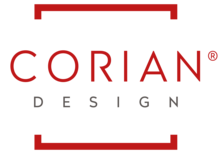
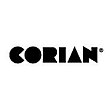
Corian is a brand of solid surface material created by DuPont. Its primary use is as a countertop, benchtop surface, wash basin, and wall panel. It is composed of acrylic polymer and alumina trihydrate (ATH), a material derived from bauxite ore.


Corian is a brand of solid surface material created by DuPont. Its primary use is as a countertop, benchtop surface, wash basin, and wall panel. It is composed of acrylic polymer and alumina trihydrate (ATH), a material derived from bauxite ore.
Corian is the original material of this type, created by DuPont scientists in 1967.[1]
Corian is manufactured in three thicknesses: 6 millimetres (0.24 in), 12 millimetres (0.47 in), and 19 millimetres (0.75 in). Most Corian is manufactured at a DuPont facility near Buffalo, New York. Cross-section cuts show consistent color and particulate patterning evenly distributed throughout the material, giving rise to the category name "solid surface".
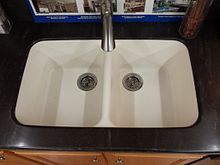
Donald Slocum, a DuPont chemist, is credited with inventing Corian solid surface in 1967.[2] His name appears on the patent issued in October 1968.[3] The product was first introduced for sale in 1971, at the National Association of Home Builders meeting in Houston, Texas.[1]
Originally conceived as a kitchen and bath material available in a single color, Corian is manufactured and delivered in more than 100 colors.[4]
In 2013, the company announced its Endless Evolution initiative in an effort to improve the material and find additional applications for its use.[5] As part of this initiative, in 2014 DuPont introduced its "Deep Color" technology.[6] The enhancement allows for the material to be created in deeper, darker colors that are more resistant to scratches and cuts than earlier generation Corian material.[7]
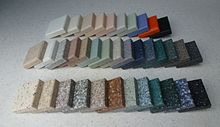

DuPont has issued various sub-branded releases of the material. Notably these have included:
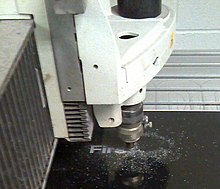

Corian consists mainly of aluminum trihydroxide (55-60%) and polymethyl methacrylate (34-45%) with trace elements of iron oxide black, carbon black, titanium dioxide, colorants and methyl methacrylate.[12] Its characteristics includes:
Heat resistance: the material is heat resistant up to 100°C (212°F), but can be damaged by excess heat. DuPont recommends the use of trivets when the material is installed in kitchens.[14]
Scratches: The material can be scratched, with scratches particularly noticeable on darker colors.
Corian does not lose its visual appearance or fade for many years, sometime decades.
Corian meets or exceeds current emissions guidelines for volatile organic compounds (VOCs), hazardous air pollutants (HAPs) and is "Greenguard Indoor Air Quality Certified". Corian is nontoxic and nonallergenic to humans. It is free of heavy metals and complies with the EU Directive 2002/95EC on the Restriction of Hazardous Substances (RoHS). Its hygienic properties make it popular in installations where maintaining sanitary conditions is important (e.g. hospitals and restaurants).[15]
In 2014, the New England Journal of Medicine reported a case of a 64-year-old exercise physiologist who died from lung disease consistent with idiopathic pulmonary fibrosis after 16 years of exposure to Corian dust. Dust from Corian was found in the patient's shop of Corian fabrication and lung upon autopsy. The authors said that the case was consistent with Corian dust causing idiopathic pulmonary fibrosis, but did not prove causality.[16] DuPont scientists responded that exposure to other materials could not be ruled out, nor did they rule out it was not caused from the dust which consists of aluminum trihydrate (ATH) derived from bauxite. Fabricators must properly protect themselves from fine Corian particulates generated during milling, and sanding. Fabricators should always wear a proper certified respirator and keep shop and environment clean of Corian dust at all times.